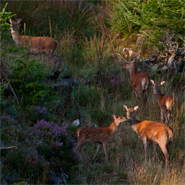Posted 18 April 2012
Kerry red deer ancestry traced to population introduced to Ireland by ancient peoples over 5,000 years ago
Research findings recently published in the journal Quaternary Science Reviews show that red deer populations were introduced to Ireland by ancient peoples from Britain during the Neolithic period over 5,000 years ago.
The international team of scientists from Ireland, Austria, the UK and the US, who conducted the study, also discovered that today’s red deer population in County Kerry, the Southwest of Ireland, can trace their ancestry to one of these ancient deer populations and as such merit special conservation status.
Pictured far right: Kerry red deer image (copyright Ruth Carden)
To identify the origin of the Kerry red deer the scientists compared DNA from ancient deer bone specimens held in the National Museum of Ireland to the DNA of modern deer including the DNA of European deer populations.
The Irish Neolithic Period (c.4000 – 2500 BC) was when agricultural communities became established in Ireland. This involved the introduction of domesticated plants and animals to the island. The red deer appear to have been introduced as part of this change.
The study findings concur with archaeological evidence, which also suggests a special relationship between humans and red deer during prehistoric times. Antler fragments and tools are frequently found in Neolithic, Bronze Age and Iron Age excavations.
According to Dr Ruth Carden, a researcher from the National Museum of Ireland, who led the study, the Kerry red deer represent a ‘unique population within an Irish context’ and therefore should be given ‘special conservation and management status within Ireland’.
“We have very few native mammals in Ireland, but certainly those that arrived with early humans, such as the red deer, are every bit as Irish as the Irish themselves,” says Dr Allan McDevitt a geneticist from the UCD School of Biology and Environmental Science, University College Dublin who was involved in the study.
“[This study] brings to light new aspects on the history of our natural heritage as well as its cultural relevance. Our heritage is as intertwined in our everyday lives today as it was in the lives of our ancestors and we can only hope that important research such as this continues to get support ensuring a greater understanding of our natural heritage,” says Michael Starrett, CEO, The Heritage Council of Ireland.
The research was co-funded by The Heritage Council of Ireland, Kerry County Council, Screebe Estate Galway, and The Irish Research Council for Science, Engineering, and Technology (IRCSET).
The findings were published in the scientific journal Quaternary Science Reviews on 30th March 2012.
Scientific paper
Phylogeographic, ancient DNA, fossil and morphometric analyses reveal ancient and modern introductions of a large mammal: the complex case of red deer (Cervus elaphus) in Ireland.
(Produced by UCD University Relations)

